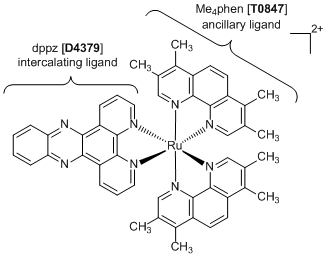Maintenance Notice (10:30 PM January 4 - 8:00 AM January 5, 2025 UTC): This website is scheduled to be unavailable due to maintenance. We appreciate your patience and understanding.
Published TCIMAIL newest issue No.197 | Notice of Discontinuing the Use of Password-Protected Compressed Files | Various analytical charts can be searched on each product detail page and Product Document Search (The kinds of analytical charts differ by product)
Maximum quantity allowed is 999
Please select the quantity
Ruthenium Complex Acting as a Light Switch for DNA Mismatches
Barton et al. have reported a ruthenium complex which emits strongly at mismatches in DNA. According to their results, a ruthenium complex [Ru(Me4phen)2dppz]2+ coordinated with two molecules of 3,4,7,8-tetramethyl-1,10-phenanthroline (Me4phen) and one molecule of dipyrido[3,2-a:2',3'-c]phenazine (dppz), acts as a light switch in the presence of DNA emitting light having a maximum emission spectrum between 650 and 660 nm. This complex has more than a 20-fold higher binding affinity toward double-stranded DNA with a single base mismatch compared with well-matched double-stranded DNA, and has about a five times longer emission lifetime. From quenching experiments using a copper complex, it is strongly indicated that the metalloinsertion of the ruthenium metal occurs at the mismatch base pair from the minor groove side of DNA, and the dppz ligand of the ruthenium complex is deeply inserted into the double-stranded DNA thereby effectively controlling quenching by water. In this way, [Ru(Me4phen)2dppz]2+ acts as a light switch and is expected to be applied for detection of failure of DNA repair and diagnosis of initial cancers.

References
- [Ru(Me4phen)2dppz]2+, a Light Switch for DNA Mismatches